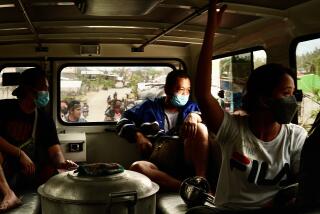Gulf War Fueled Philippine Jeepney Use
- Share via
MANILA — The thunderous pounding and clanging at Sarao Motors is one sign that the Gulf War was good for the jeepney business.
After Iraq’s invasion of Kuwait, gasoline prices almost doubled here and forced Filipinos to leave their cars at home. Many rode the diesel-powered jeepney, the Philippines’ venerable mode of popular transportation, at fares only moderately higher due to smaller increases in diesel fuel costs.
Seeing a business opportunity were hundreds of Philippine workers who fled home from the Persian Gulf with substantial savings but no jobs. Suddenly, scores of new jeepneys joined Manila’s clogged streets. Orders for new jeepneys jumped.
Amid the din of workmen soldering and hammering new jeepney hulks, Gary (Boy) Sarao boasts at least a two-month backlog.
“We thought that when the war came, it would be bad business for us,” said the 32-year-old engineer who runs the factory with his father. “But it turned out the other way around, thanks to Saddam.”
“Lots of guys have come home (from the Gulf) and don’t know where to invest their money,” he continued. “What a guy will do is buy a jeepney and that will provide a good (income) every day.”
The Saraos claim to be the first to build jeepneys after World War II. By upgrading the Jeep, the workhorse U.S. military vehicle of that war, Sarao Motors has become the most-enduring major jeepney producer in the country.
“Right after the war, there were lots of Jeeps that the Americans didn’t want to ship back to the U.S. because of the cost. So they sold them on the surplus market and people cut them in half and extended the chassis,” Boy Sarao said.
“Across the street used to be a saloon where American soldiers had fun. We took it over, and it was there that we created the first jeepney,” he added.
Today, Sarao estimates, there are tens of thousands of jeepneys in the Philippines, most of them in Manila. Sarao Motors has even exported jeepney bodies overseas: to a pizza chain in Wisconsin, a hotel group in Hawaii, and a world’s fair in Tennessee.
Ben Gelera, now retired, remembers when he headed a 30-man team and built Sarao’s first jeepney.
“I can’t count how many I’ve made,” said the mechanic who had his own jeepney in for repairs.
The heart of the jeepney is a second-hand, four-cylinder diesel engine, imported from Japan for about $800, that is rebuilt and overhauled.
Sarao offers three sizes of jeepneys, for 16 to 20 passengers, and three model choices. An ordinary jeepney, made of galvanized steel, sells for about 235,000 pesos ($7,800); a super-deluxe for 245,000 pesos ($8,000), which includes some stainless steel; and a new 1991 model, made almost entirely of stainless steel, that runs 300,000 pesos ($10,000).
Customized designs and decorations are extra. Many jeepneys sport the Sarao trademark, a horse hood ornament. It was introduced, Sarao said, by his father, “who before the war was a horse rider and liked John Wayne movies.”
Almost 50% of the Jeepney body is made from recycled material. In the past, most parts were hand-shaped; today, hydraulic presses do some of the work.
However, the bodies are still assembled and pounded into shape by hand. “Without the hammering and the pounding, our guys would fall asleep,” Sarao said.
Enrico Ortega, a 46-year-old commercial artist, is a proud and satisfied new owner. He sold his interest in an art design company last year and sank part of the money into a new $8,800 jeepney.
Parked at a Manila street corner, Ortega’s 18-seat jeepney features a generous amount of chrome, leather seats, a stereo system and curtains.
Painted above the windshield is “Mary Hayden.” The jeepney is named for Ortega’s infant daughter. Across the back is the reminder: “God loves us.”
“I came up with the ideas for the design and decoration myself,” said Ortega, who employs a driver for his vehicle and earns on average 400 pesos (about $13) a day. “If you have a jeepney, you had better drive it. You had better not let it sit around.”






